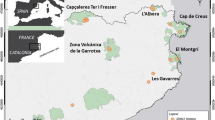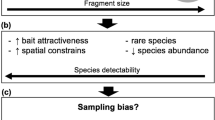Abstract
Improving species community diversity studies needs population abundances to be calculated. Micro-mammal population densities are highly variable at small spatial scales. Mark-recapture methods based on grid trapping is the most reliable technique to study density in small rodents, albeit it is time-consuming because it necessitates increasing the number of spatial replicates. Here, we evaluated a live-trapping grid strategy to minimise field effort without decreasing the accuracy of small rodent population density estimations. We first computed spatially explicit estimates of population density using CMR histories from a large grid made by 100 traps set over 4 consecutive days and nights trapped twice per year between 2012 and 2015, and compared these estimates with those obtained from reduced session time and grid extent for two common rodent species: the wood mouse (Apodemus sylvaticus) and the bank vole (Myodes glareolus). We then compared density estimates to simpler catch-effort indexes of abundance for these rodents. Spatially explicit density estimates from capture-mark-recapture over 4 consecutive days from grids set with a single trap interspaced 5m on a 10x10 square were highly correlated (R2 = 0.945) with density estimates after 4 consecutive days on a 7 × 7 square arrangement. The best performance of catch-effort indexes relative to 4 days on 10 × 10 square grid spatial density estimates for these two rodents was found when using total trapping events recorded on 8 × 8 grids over 4 days or 9 × 9 over 3 days (R2 = 0.947 and 0.945 respectively). Our results support the use of a reduced grid design over 4 days to obtain reliable spatially explicit density estimates. We also obtained a reduced duration of trapping at the expense of keeping larger grids when using catch-effort indexes.
Similar content being viewed by others
References
Angold, P.G., Sadler, J.P., Hill, M.O., Pullin, A., Rushton, S., Austin, K., Small, E., Wood, B., Wadsworth, R., Sanderson, R., Thompson, K., 2006. Biodiversity in urban habitat patches. Sci. Total Environ. 360, 196–204, https://doi.org/10.1016/j.scitotenv.2005.08.035.
Benhamou, S., 1990. An analysis of movements of the wood mouse Apodemus sylvaticus in its home range. Behavioural Processes 22, 235–250, https://doi.org/10.1016/0376-6357(91)90097-J.
Borchers, D.L., Efford, M.G., 2008. Spatially explicit maximum likelihood methods for capture-recapture studies. Biometrics 64, 377–385, https://doi.org/10.1111/j.1541-0420.2007.00927.x.
Bordes, F., Blasdell, K., Morand, S., 2015. Transmission ecology of rodent-borne diseases: new frontiers. Integr. Zool. 10, 424–435, https://doi.org/10.1111/1749-4877.12149.
Bradley, C.A., Altizer, S., 2006. Urbanization and the ecology of wildlife diseases. Trends Ecol. Evol. 22, 95–102, https://doi.org/10.1016/j.tree.2006.11.001.
Brown, L.E., 1954. Small mammal populations at silwood park field centre, Berkshire, England. Am. Soc. Mammal. 35, 161–176.
Brown, L.E., 1956. Movements of some British small mammals. J. Anim. Ecol. 25, 54–71.
Brown, L.E., 1969. Field experiments on the movements of Apodemus sylvaticus L. using trapping and tracking techniques. Oecologia 2, 198–222.
Chitty, D., 1937. A ringing technique for small mammals. J. Anim. Ecol. 6, 36–53.
Crawley, M.C., 1969. Movements and home-ranges of clethrionomys glareolus Schreber and Apodemus sylvaticus L. in North-East England. Oikos 20, 310–319.
Dickman, C.R., 1999. Rodent-ecosystem relationships: a review. In: Singleton, G.R., Hinds, L.A., Leirs, H., Zhang, Z. (Eds.), Ecologically-Based Management of Rodent Pests. ACIAR Monograph, pp. 113–133.
Dickman, C.R., Doncaster, C.P., 1987. The ecology of small mammals in urban habitats. I. Populations in a patchy environment. J. Anim. Ecol. 56, 629–640.
Efford, M., 2004. Density estimation in live-trapping studies. Oikos 3, 598–610.
Efford, M.G., Borchers, D.L., Byrom, A.E., 2009. Density estimation by spatially explicit capture-recapture: likelihood-based methods. In: Modeling Demographic Processes in Marked Populations. Springer US, pp. 255–269.
Eskildsen, A., 2010. Effects of resource abundance on habitat selection and spatial behavior of the bank vole (Myodes glareolus). In: Doctoral dissertation, M.Sc. thesis. University of Copenhagen, Department of Biology, pp. 36.
Fitzgerald, B.M., Efford, M.G., Karl, B.J., 2004. Breeding of house mice and the mast seeding of southern beeches in the Orongorongo Valley, New Zealand. New Zeal. J. Zool. 31, 167–184, https://doi.org/10.1080/03014223.2004.9518370.
Flowerdew, J.R., Shore, R.F., Poulton, S.M.C., Sparks, T.H., 2004. Live trapping to monitor small mammals in Britain. Mamm. Rev. 34, 31–50, https://doi.org/10.1046/j.0305-1838.2003.00025.x.
Gerber, B.D., Parmenter, R.R., 2015. Spatial capture-recapture model performance with known small-mammal densities. Ecological 25, 695–705, https://doi.org/10.1890/14-0960.1.
Gurnell, J., Gipps, J.H.W., 1989. Inter-trap movement and estimating rodent densities. J. Zool. Lond. 217, 241–254.
Ivan, J.S., White, G.C., Shenk, T.M., 2013. Using simulation to compare methods for estimating density from capture—recapture data using simulation to compare methods for estimating density from capture—recapture data. Ecology 94, 817–826, https://doi.org/10.2307/23436295.
Kikkawa, J., 1964. Movement, activity and distribution of the small rodents clethrionomys glareolus and Apodemus sylvaticus in Woodland. J. Anim. Ecol. 33, 259–299.
Krebs, C.J., Boonstra, R., Gilbert, S., Reid, D., Kenney, A.J., Hofer, E., 2011. Density estimation for small mammals from live trapping grids: rodents in northern Canada. J. Mammal. 92, 974–981, https://doi.org/10.1644/10-MAMM-A-313.1.
Le Quilliec, P., Croci, S., 2006. Piégeage de micromammifères Une nouvelle boîte-dortoir pour le piège non vulnérant Inra. Méthodes Outil. pour l’observation l’évaluation des milieux For. prairiaux Aquat. 125–128.
Legendre, P., Legendre, L., 2008. Numerical Ecology. Elsevier, Amsterdam, The Netherlands, pp. 853.
Manning, T., Edge, W.D., Wolff, J.O., 1995. Evaluating population-size estimators: an empirical approach. Am. Soc. Mammal. 76, 1149–1158.
McKinney, M.L., 2002. Urbanization, biodiversity and conservation. Bioscience 52, 883–890.
Morand, S., Krasnov, B.R., Poulin, R., Degen, A.A., 2006. Micromammals and macroparasites: Who is who and how they interact? In: Morand, S., Krasnov, B.R., Poulin, R. (Eds.), Micromammals and macroparasites. Springer-Verlag, Tokyo, pp. 3–9.
Morand, S., Chaisiri, K., Chaval, Y., Claude, J., Tran, A., Herbreteau, V., 2015. Assessing the distribution of disease-bearing rodents in human-modified tropical landscapes. J. Appl. Ecol. 52, 784–794, https://doi.org/10.1111/1365-2664.12414.
Nelson, L., Clark, F.W., 1973. American society of mammalogists correction for sprung traps in catch/effort calculations of trapping results. J. Mammal. 54, 295–298.
OJEU, 2010. Directive 2010/63 EU of the European Parliament and of the Council.
Otis, D.L., Burnham, K.P., White, G.C., Anderson, D.R., 1978. Statistical inference from capture data on closed animal populations. 1978 62, 3–135, https://doi.org/www.jstor.org/stable/3830650.
Parmenter, R.R., Yater, T.L., Anderson, D.R., Burham, K.P., Dunnum,J.L, Franklin, A.B., Friggens, M.T., Lubow, B.C., Miller, M., Olson, G.S., Parmenter, C.A., Pollard, J., Rexstad, E., Shenk, T.M., Stanley, T.R., White, G.C., 2003. Small-mammal density estimation: a field comparison of grid-based VS. web-based density estimators. Ecol. Monogr. 73, 1–26.
Pavoine, S., Bonsall, M.B., 2011. Measuring biodiversity to explain community assembly: a unified approach. Biol. Rev. 86, 792–812, https://doi.org/10.1111/j.1469-185X.2010.00171.x.
Pavoine, S., 2016. A guide through a family of phylogenetic dissimilarity measures among sites. Oikos 125, 1719–1732, https://doi.org/10.1111/oik.03262.
Pearson, D.E., Ruggiero, L.F., 2003. Transect grid trapping arrangements for sampling communities. Wildl. Res. 31, 454–459.
Pelikán, J., 1971. Calculated densities of small mammals in relation to quadrat size. Annales 8, 3–6.
Pelikán, J., Zejda, J., Holisova, V., 1964. On the question of investigating small mammal populations by the quadrate method. Acta Theriol. (Warsz) IX, 1–24.
Preatoni, D.G., Zilio, A., Cantini, M., 1997. A model to opttmtze trap systems used for small mammal (Rodentia, Insectivora) density estimates. Hystrix 9, 31–37.
Quéré, J.-P., Le Louarn, H., 2011. Les rongeurs de France: faunistique et biologie. Editions Quae, Versailles, France, 256 pp.
R Development Core Team, The R Foundation for Statistical Computing, 2017, https://doi.org/www.r-project.org/foundation/.
Read, V.T., Malafant, K.W.J., Myers, K., 1998. A comparison of grid and index-line trapping methods for small mammal surveys. Wildl. Res. 15, 673–687, https://doi.org/10.1071/WR9880673.
Rézouki, C., Dozières, A., Le Cœur, C., Thibault, S., Pisanu, B., Chapuis, J.L., Baudry, E., 2014. A viable population of the European red squirrel in an urban park. PloS one 9, e105111, https://doi.org/10.1371/journal.pone.0105111.
Rizzoli, A., Silaghi, C., Obiegala, A., Rudolf, I., Földvári, G., 2014. Ixodes ricinus and its transmitted pathogens in urban and peri-urban areas in Europe: new hazards and relevance for public health. Front. Public Heal. 2, 1–26, https://doi.org/10.3389/fpubh.2014.00251.
Romairone, J., Jiménez, J., Luque-Larena, J.J., Mougeot, F., 2018. Spatial capture-recapture design and modelling forthe study of small mammals. PLoS One 13, 1–22, https://doi.org/10.1371/journal.pone.0198766.
Ruscoe, W.A., Goldsmith, R., Choquenot, D., 2001. A comparison of population estimates and abundance indexes for house mice inhabiting beech forests in New Zealand. Wildl. Res. 28, 173–178.
Shochat, E., Warren, P., Faeth, S., McIntyre, N., Hope, D., 2006. From patterns to emerging processes in mechanistic urban ecology. Trends Ecol. Evol. 21, 186–191, https://doi.org/10.1016/j.tree.2005.11.019.
Sollmann, R., Gardner, B., Chandler, R.B., Shindle, D.B., Onorato, D.P., Royle, J.A., O’ Connell, A.F., 2013. Using multiple data sources provides density estimates for endangered Florida panther. J. Appl. Ecol. 50, 961–968, https://doi.org/10.1111/1365-2664.12098.
Steele, B.B., Bayn, R.L., Val Grant, C., 1984. Environmental monitoring using populations of birds and small mammals: analyses of sampling effort. Biol. Conserv. 30, 157–172, https://doi.org/10.1016/0006-3207(84)90064-8.
Sun, C.C., Fuller, A.K., Royle, J.A., 2014. Trap configuration and spacing influences parameter estimates in spatial capture-recapture models. PLoS One 9, 1–9, https://doi.org/10.1371/journal.pone.0088025.
Theuerkauf, J., Rouys, S., Jourdan, H., Gula, R., 2011. Efficiency of a new reverse-bait trigger snap trap for invasive rats and a new standardised abundance index. Ann. Zool. Fennici 48, 308–318.
Torre, I., Raspall, A., Arrizabalaga, A., Diaz, M., 2018. SEMICE: an unbiased and powerful monitoring protocol for small mammals in the Mediterranean region. Mamm. Res. 88, 161–167, https://doi.org/10.1016/j.mambio.2017.10.009.
Williams, B.K., Nichols, J.D., Conroy, M.J., 2002. Management of Animal Populations: Modeling, Estimation, and Decision Making. Academic Press, San Diego, U.S.A., 818 pp.
Wolton, R.J., 1985. The ranging and nesting behaviour of Wood mice, Apodemus sylvaticus (Rodentia: Muridae), as revealed by radio-tracking. J. Zool. 206, 203–222, https://doi.org/10.1111/j.1469-7998.1985.tb05645.x.
Zuur, A.F., Ieno, E.N., Walker, N.J., Saveliev, A.A., Smith, G.M., 2009. Mixed Effects Models and Extensions in Ecology with R. Springer, New York, 574 pp.
Zuur, A.F., Ieno, E.N., Elphick, C.S., 2010. A protocol for data exploration to avoid common statistical problems. Methods Ecol. Evol. 1, 3–14.
Zuur, A.F., Hilbe, J.M., Ieno, E.N., 2013. Beginner’s Guide to GLM and GLMM with R. Newburgh. Highland Statistics Ltd, 256 pp.
Author information
Authors and Affiliations
Corresponding author
Rights and permissions
About this article
Cite this article
Castañeda, I., Pisanu, B., Díaz, M. et al. Minimising trapping effort without affecting population density estimations for small mammals. Mamm Biol 93, 144–152 (2018). https://doi.org/10.1016/j.mambio.2018.10.004
Received:
Accepted:
Published:
Issue Date:
DOI: https://doi.org/10.1016/j.mambio.2018.10.004




